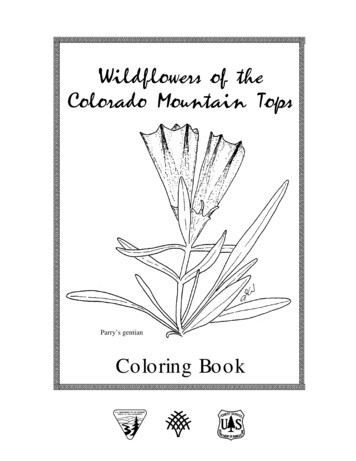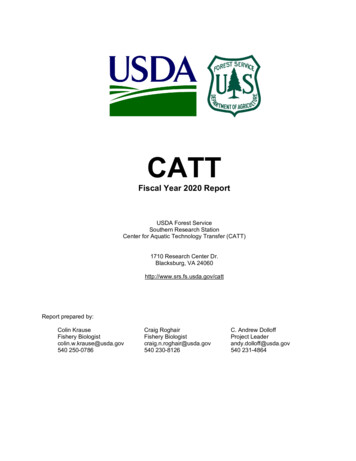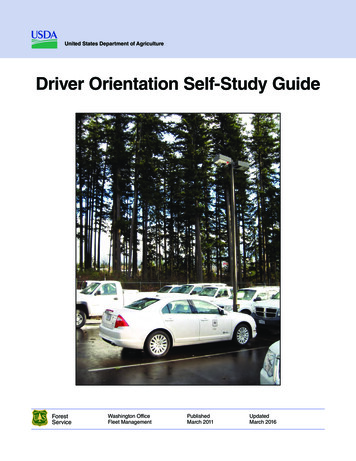
Transcription
Parry’s gentianColoring Book
Mountain Tops of ColoradoThe Rocky Mountains are a large mountain range that reach from Canada all the way to Texas. At thetop of these enormous mountains is the alpine tundra, a cold and windy environment. Remarkably,many colorful wildflowers are found in the alpine tundra during the summer. This coloring book displays some of the wildflowers that are found in Colorado’s alpine tundra and the subalpine forestsbelow.Colorado has many peaks that extend into the alpine, including over fifty mountains that areabove 14,000 feet. The alpine tundra begins between 11,200 and 12,000 feet above sea level.“Tundra” is a Russian word meaning “land with no trees.” The harsh environment at the top of ourmountain peaks is so cold and windy that most trees cannot survive. During the winter, the winds canreach speeds up to 100 mph and temperatures are usually far below freezing. The upper limit ofwhere trees can survive is called “tree line”. It is also the transition between the subalpine forests andthe alpine tundra.The subalpine forests are made up of coniferous trees, mostly Engelman Spruce and SubalpineFir. Most conifers do not lose all of their leaves during the winter. The leaves slowly fall off throughout the year and are replaced by fresh leaves. The leaves are usually dark green and in the shape of aneedle. The trees found in the transition between the subalpine forests and alpine tundra are oftensmall and deformed due to the high winds that blow over mountain tops. Occasionally, one can find atree that looks like a flag pole. The branches only grow on one side of the tree because the winds areincredibly strong and usually blow from the same direction. When the trees are no longer present weare in the alpine tundra.The only time when the temperature is warm enough for plants to flower in the tundra is during the summer months. Most alpine plants are perennials. This means that they live for more thanone year. Some alpine plants live for many years and could be older than you! Due to the high windsand harsh climate most plants that grow at high elevations are short and stout. The small size helps toprotect the plants from the wind. Often alpine plants will grow in the cracks and crevices of rock outcrops in order to stay out of the wind and intense sunlight. Most alpine environments are very dryduring the summer and winter. This additional stress has forced the alpine plants to adapt dry conditions. During the winter the water is locked up as snow and therefore unavailable to the plants. Thesummer is often dry due to the intense sunlight and lack of summer rain.The alpine environment has a few year-round animal residents, including: pocket gophers,voles, shrews, pikas, marmots, weasels, and white-tailed ptarmigans. Most of these species are small,very furry, and hibernate during the winter. These adaptations help them to survive the harsh winters.During the warmer months elk, big-horned sheep and many birds visit the alpine tundra. Most alpineareas have avoided human disturbance, such as logging or mining due to their inaccessibility.Currently, more and more people are begin to use the alpine for recreation including: hiking, camping, and skiing. Please enjoy and respect the alpine environment.
Life ZonesAn important clue in wildflower identification is where the plant grows. As you travel along the roadsof Colorado, you have probably noticed that certain kinds of wildflowers and trees belong at certain altitude and are not found much above or below these limits. Therefore, you expect to find different plantson top of Mt. Evans (above tree line) than you would at Red Rocks amphitheater (foothills).These changes are called life zones. In Colorado there are 5 life zones, based on the changes scientistssee in plant and animal life with increasing elevation.AlpineHighest elevation zone, above tree12,000 ftSubalpinedense forestedEnglemann spruce, subalpine fir, aspen,limber or bristlecone pine may be foundon ridges, lush meadows and riparianTree line10,000 ftMontaneforestedDouglas fir, aspen and lodgepole pine,ponderosa pine is found on warm, dryslopes; white fir or blue spruce can befound in canyons, along streams8,000 ftFoothillsOften called the shrub zone, gambeloak, pinon pine, juniper, sagebrush,grasslands, and ripariandry shrub andwoodlands6,000 ftPlains4,000 ftLow elevation, no trees exceptalong rivers; grasslands, riparian,shrublands
1411142222225 & 102Northern Fairy CandelabraElephantella1121410 & 1129 & 1022Alpine Spring BeautyBoykinia1 Red7 Violet/Purple13 Violet-Red19 Cerulean2 Green8 Orange14 Carnation20 Blue Violet3 Blue9 Gray21 Blue Green4 Yellow10 White15 Red Orange16 Vivid5 Brown6 Black11 Fuchsia12 Red-Violet17 Yellow Orange 23 Yellow Green18 Peach24 Green Yellow22 Jungle Green
Northern Fairy CandelabraAndrosace septentrionalis Primulaceae the Primrose FamilySometimes this plant is also called Rock Jasmine. It is widespread in forested or opensites on rocky soils from the foothills up to alpine tundra. “Septentrionalis” is Latin for“plant of the north”. This plant is an annual, which means that it lives for only onegrowing season, and new plants come up from seed each year.
ElephantellaPedicularis groenlandica Scrophulariaceae the Snapdragon FamilyWet mountain meadows and along streambanks, often in large masses. Each flowerresembles an elephant’s head. Elk eat this plant in the early summer. It can be foundfrom Alaska to Labrador, south to Saskatchewan, New Mexico, and California.
Alpine Spring Beaut yClaytonia megarhizaPortulacaceae the Purslane FamilyAmong the rocks or in rock crevices in tundra on the higher peaks. They start bloomingvery early in the season, just after the snow melts. “Megarhiza” means “big root”, andindeed, it can grow up to six feet long! This flower can be seen on Mount Evans alongthe Mt. Goliath Trail. The leaves are often eaten by marmots, pikas, and ground squirrels.
BoykiniaTelesonix jamesii Saxifragraceae the Saxifrage FamilyScattered on granite or limestone outcrops along the Front Range from Pike’s Peak toRocky Mountain National Park. This plant prefers rocky soils, talus and vertical cracks.It is is one of our most beautiful native plants, named for Edward James, an 1800’sAmerican Naturalist.
41910 & 32222525Marsh MarigoldAlpine Sorrel44410 & 1221219&255Silky PhaceliaYellow stonecrop1 Red7 Violet/Purple13 Violet-Red19 Cerulean2 Green8 Orange14 Carnation20 Blue Violet3 Blue9 Gray21 Blue Green4 Yellow10 White15 Red Orange16 Vivid5 Brown6 Black11 Fuchsia12 Red-Violet17 Yellow Orange 23 Yellow Green18 Peach24 Green Yellow22 Jungle Green
Marsh MarigoldCaltha leptosepala Asteraceaethe Sunflower FamilyFound on wet ground along streams, in mountain meadows, and in tundra. Flowers veryearly, often in large patches while snow is still on the ground nearby. “Leptosepala”means slender “sepals” or petals. A related species in the eastern United States waseaten by American Indians, but this species is reported to be much too bitter.
Alpine SorrelOxyria dygina Polygonaceae the Buckwheat FamilyGrows in the tundra in shady or moist places, such as rock crevices or ledges. “Oxyria”comes from the Greek word “oxys”, which means sour. The leaves are sour tasting, butpeople should not be eat them since they are mildly toxic. This plant is distributedaround the world in the northern countries of Europe, Asia, and North America. It iswind pollinated, rather than relying on insects such as bees.
Silky PhaceliaPhacelia sericea Hydrophyllaceae the Waterleaf FamilyCommon on gravelly open slopes, and along roadsides or in other areas of disturbedsoil, usually above 10,000 feet. “Sericea” means “silky”. Elk and other big game grazeit during spring and summer.
Yellow stonecropSedum lanceolatum Crassulaceae the Stonecrop familyCommon on dry, rocky soils on ridges, slopes, and rocky outcrops from the plains up tothe tundra. “Sedum” is Latin for “to sit”, probably referring to the fact that these veryshort plants “sit” on the ground. It has yellow star-shaped flowers and fleshy leaves.This is a close relative of the Sedum species grown in rock gardens.
9344&1229&29&2Alpine Forget-Me-NotWestern Yarrow10 & 4410 &4112222210 & 5Mountain Death CamusArtic Gentian1 Red7 Violet/Purple13 Violet-Red19 Cerulean2 Green8 Orange14 Carnation20 Blue Violet3 Blue9 Gray21 Blue Green4 Yellow10 White15 Red Orange16 Vivid5 Brown6 Black11 Fuchsia12 Red-Violet17 Yellow Orange 23 Yellow Green18 Peach24 Green Yellow22 Jungle Green
Alpine For get-Me-NotEritrichium aretoides Boraginaceae the Borage FamilyTiny bright blue flowers arise from a dense mat of small, hairy, silver-white leaves.Look closely at the flowers and you will see that they have five petals and a yellow center or “eye”. Sometimes you can find alpine forget-me-nots with white flowers.Remember the Alpine!
Western Yarro wAchillea lanulosa Asteraceae the Sunflower FamilyThis flat-topped white flowered species is common in meadows and along roads fromthe sagebrush to the alpine. It has a long history of medicinal use. It is easy to grow in aflower garden, but can take over if watered too much.
Mountain Death CamusZigadenus elegans Melanthiaceae the False Hellebore FamilyThis is a mildly poisonous plant found in subalpine meadows and bogs. Zigadenusspecies in the Eastern United States are much more toxic, even deadly. Sometimes ourMountain death camus grows along the edges of moist, bog-like aspen groves.
Arctic GentianGentiana algida Gentianaceae the Gentian FamilyThis very attractive flower blooms late in the summer in the alpine and sub-alpinezones. Algida means cold, a reminder of the cold arctic climate. These gentians can befound from Alaska south through the Rockies to New Mexico in alpine bogs and meadows.
494422222210 & 522Alp LilyOld Man of the Mountains32114310 & 529&2Moss PinkSky Pilot1 Red7 Violet/Purple13 Violet-Red19 Cerulean2 Green8 Orange14 Carnation20 Blue Violet3 Blue9 Gray21 Blue Green4 Yellow10 White15 Red Orange16 Vivid5 Brown6 Black11 Fuchsia12 Red-Violet17 Yellow Orange 23 Yellow Green18 Peach24 Green Yellow22 Jungle Green
Alp LilyLloydia serotina Liliaceae the Lily FamilyThis delightful little alpine lily grows only two to six inches tall in gravelly ridges,cliffs, rock crevices and alpine meadows in the higher mountains. It is common on thetundra when blooming in June and July.
Old Man of the MountainsHymenoxys grandiflora Asteraceae the Sunflower FamilyA grand flower indeed!! This is one of the showiest and most easily recognized alpineplants. Stout woolly stems are topped by bright yellow heads two to four inches acrosswith 3-notched ray flowers. It blooms late in the summer and is very common on highpeaks and alpine meadows. The heads of these flowers usually face away from the prevailing winds.
Moss PinkSilene acaulis Caryophyllaceae the Pink FamilyThe base of this plant is low and matted, like moss, with little pink flowers barely tallerthan the mat. This slow growing species blooms in early July. This species is sometimesused as a rock garden plant.
Sky PilotPolemonieum viscosumPolemoniaceaethe Phlox FamilySmell Something? Sky pilots can have a mild skunk like aroma along with their deepblue flowers and sticky glandular leaves. Most often these flowers are found above timberline in open rocky places like boulderfields and alpine meadows. Sometimes you canfind a rare white flowered sky pilot in a population of the blue flowered ones.
4 & 1011114222 & 102 & 1010 & 5Rocky Mountain ThistleShooting Star1&294111399&29&221&210 & 5FireweedMountain Dryad1 Red7 Violet/Purple13 Violet-Red19 Cerulean2 Green8 Orange14 Carnation20 Blue Violet3 Blue9 Gray21 Blue Green4 Yellow10 White15 Red Orange16 Vivid5 Brown6 Black11 Fuchsia12 Red-Violet17 Yellow Orange 23 Yellow Green18 Peach24 Green Yellow22 Jungle Green
Rocky Mountain thistleCirsium scopulorum Asteraceae the Sunflower FamilyNot all thistles are weeds!! This woolly native is common along the continental divide.Stout stems hold nodding white or cream colored heads of flowers in dense woolly orcobwebby clusters. The leaves, like many thistles, are spiny. This is a common thistle ofalpine and subalpine slopes, flowering in July and August.
Shooting S tarDodecatheon pulchellum Primulaceae the Primrose FamilyThese plants have attractive rose-pink flowers arranged in drooping clusters on a leafless flowering stalk. The common name actually describes the flowers: bent back petalswith fused yellow anthers forming a beak. The best place to find them are along streamsand other wet places.
FireweedEpilobium angustifoliumOnagraceaethe Evening-primrose FamilyThe brilliant rose-purple flowers are bundled closely together near the top of the plant.The leaves are long, narrow, and look similar to a willow leaf. Fireweed is usuallyfound in moist areas, but commonly takes over burned areas and along roadsides.
Mountain Dr yadDryas octapetalaRosaceae the Rose FamilyThis small shrub has cream colored flowers with 8 petals per flower. The evergreenleaves are thick and shiny on top, but a dull white beneath. It is found in rocky, exposedareas of the alpine tundra.
10 & 71011442222222Parry’s PrimulaColorado Columbine7137210 & 42225Dusky beardtongueHarebell1 Red7 Violet/Purple13 Violet-Red19 Cerulean2 Green8 Orange14 Carnation20 Blue Violet3 Blue4 Yellow9 Gray21 Blue Green10 White15 Red Orange16 Vivid5 Brown6 Black11 Fuchsia12 Red-Violet17 Yellow Orange 23 Yellow Green18 Peach24 Green Yellow22 Jungle Green
Parry’s PrimulaPrimula parryiPrimulaceaethe Primrose FamilyAmazingly bright purple flowers with brilliant yellow centers make this plant a difficultone to miss. The plant is usually over a foot tall with the flowers clustered near the top.It is found along streams in alpine and subalpine habitats.
Colorado ColumbineAquilegia coeruleaRanunculaceaethe Buttercup FamilyThe Colorado Columbine is our state flower. The flowers are white and blue with largespurs pointing behind the flower. The unusual shape of the flower make it an easy plantto recognize. It is common in Aspen groves and moist, forested areas. This plant was soheavily collected in the early 1900’s that a law was passed limiting the number of flowers one person could pick in one day.
Dusky beardtonguePenstemon whippleanus Scrophulariaceaethe Figwort FamilyThe tube-shaped flowers are grouped in nodding clusters at the top of the floweringstem. The flowers are usually a dingy purple in color. This is a common wildflowerthroughout the mountains from ponderosa pine to timberline.
HarebellCampanula rotundifoliaCampanulaceaethe Bellflower FamilyThe purple flowers are bell shaped and hang slightly downward from a slender stem.This plant is very widespread. In the northern hemisphere it can be found from the lowelevation foothills all the way to the alpine tundra.
Celebrating Wildflo wersThe third week of May each year is National Wildflower Week. It is the kickoff week for ayear long season of celebrating wildflowers. National Wildflower Week is an annual eventsponsored by many federal agencies and partners in the Native Plant ConservationInitiative. This event promotes the importance of conserving and managing native plantsand plant communities in America. More than 630 million acres of public lands managedby the Bureau of Land Management, the U.S. Forest Service, the National Park Service andthe U.S. Fish and Wildlife Service are habitat for America’s wildflowers. We encourage youto explore these lands, to look for and delight in your beautiful native flora.To find out more about Celebrating Wildflowers, call the National Wildflower Hotline1-800-354-4595 from April through August. The hotline is updated weekly with currentevents and places with spectactular blooming wildflowers. Also, visit CelebratingWildflowers on the Native Plant Conservation Initiative web page ( www. nps.gov/plants/ )where you can find many of the drawings and color charts used in this coloringbook andother information about native plants.The 1999 WildflowerColoring Book is presented by:Carol Dawson -- Denver Botanic GardensAndy Kratz -- USDA Forest ServiceRenee Garfias -- Bureau of Land ManagementTom Grant -- Denver Botanic GardensCarol Spurrier -- Bureau of Land ManagementDrawings by:Karl Urban -- USDA Forest ServiceJanet Wingate -- Denver Botanic GardensKARL URBANKarl Urban was a USDA Forest Service botanist on the Umatilla National Forest in northeasternOregon. Among many other efforts, he devoted countless hours of his personal time at home tocreating wildflower drawings for “Celebrating Wildflowers” coloring books. This was a “labor oflove” for Karl. Eventually, his drawings were posted on the World Wide Web where they becameextremely popular nationwide. This coloring book is dedicated in memory of Karl Urban.
Mountain Tops of Colorado The Rocky Mountains are a large mountain range that reach from Canada all the way to Texas. At the top of these enormous mountains is the alpine tundra, a cold and windy environment. Remarkably , many colorful wildflowers are found in the alpine tundra dur











